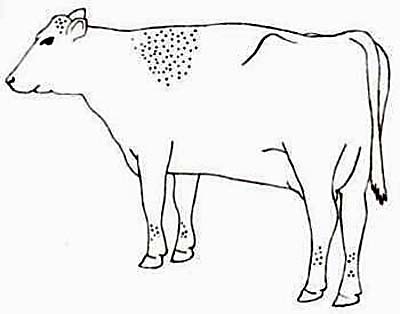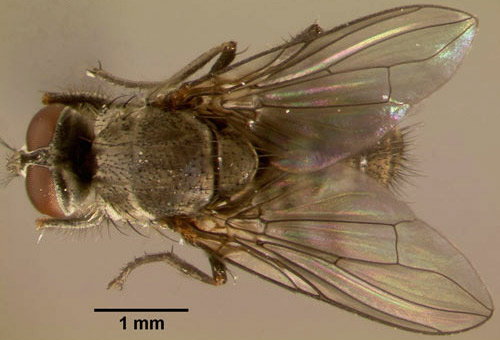Horn flies are one of the most economically damaging external parasites in beef cattle operations in Florida. The summer of 2018 in Levy County is shaping up to be a very active year for horn flies on cattle. Horn flies are dark gray and slightly smaller than houseflies. Both sexes are blood feeders, taking 20 or more blood meals each day. They primarily feed on cattle but will also feed on horses. Irritations from the bites annoy animals and occasionally, the wounds may become infected.

Where to find Horn Flies
Unlike other solitary biting flies on cattle, horn flies accumulate in groups on the tops of the shoulder and back. During extremely hot weather or hard rains, they temporarily migrate to the undersides of the host animals for protection. They fly up in swarms when disturbed but soon return to an animal. Females leave their host animal only to deposit their eggs on manure within about 10 minutes of the manure hitting the ground. Once manure crusts over due to drying, the females cannot deposit their eggs.
The summer of 2018 in Levy County is shaping up to be a very active year for
horn flies on cattle.
Horn Fly Life Cycle
Horn fly maggots can only develop in cattle manure. The life cycle from laid egg to adult fly is completed in 10 to 14 days. Each female can lay up to 500 eggs so very large populations can build up very quickly. It is common for cattle in a herd to have several hundred horn flies feeding on them at once causing the cattle not to thrive due to blood loss and expenditure of calories fighting off the flies and responding to the irritation. Bulls usually carry heavier infestations than cows and calves.
Treatment
Insecticide impregnated ear tags, dust bags, concentrated pour-ons, animal sprays, and oral larvicides available in minerals and feed supplements can all be effective in reducing horn fly problems. Ear tags impregnated with either pyrethroid or organophosphate insecticides are generally the most popular treatment options. Forced use dust bags are also popular. Both of these control methods require minimal handling of the cattle and so reduce labor costs and time spent dealing with the problem. Pour-ons, and sprays, can be effective but they require frequent treatment which may not be practical in larger herds or if time is constrained. The choice of treatments should be made based on what works best with pasture layouts and herd management practices of your operation.
Insecticide resistance has become a problem, particularly when insecticide impregnated ear tags within the same chemical class are continually used. Rotating between pyrethroid and organophosphate type tags, withholding tag application until fly numbers reach a threshold of 100 per side, and removing the tags at the end of their useful life can help to reduce resistance issues. Always follow label instructions when using any pesticide to protect your animals, yourself and the environment.
For more information about horn flies, please visit this EDIS (Electronic Data Information Source) website.
If you have any pasture or livestock questions relating to Levy County please feel free to contact Ed Jennings, UF/IFAS Extension Director for Levy County at (352) 486-5131 or by email at edjennin@ufl.edu.
 1
1

